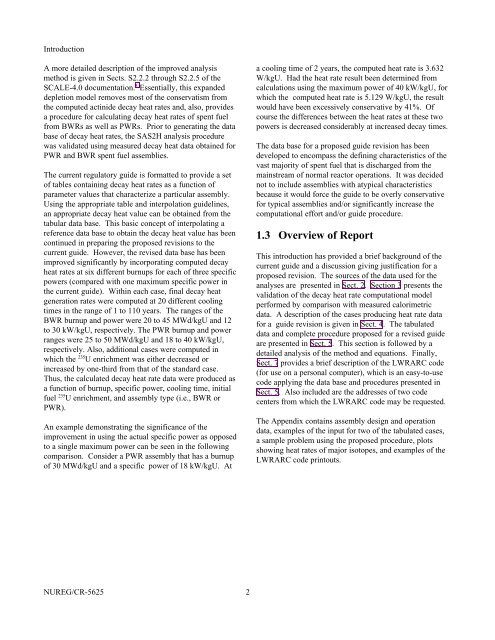NUREG/CR-5625 (ORNL-6698) - Oak Ridge National Laboratory
NUREG/CR-5625 (ORNL-6698) - Oak Ridge National Laboratory
NUREG/CR-5625 (ORNL-6698) - Oak Ridge National Laboratory
Create successful ePaper yourself
Turn your PDF publications into a flip-book with our unique Google optimized e-Paper software.
Introduction<br />
A more detailed description of the improved analysis a cooling time of 2 years, the computed heat rate is 3.632<br />
method is given in Sects. S2.2.2 through S2.2.5 of the W/kgU. Had the heat rate result been determined from<br />
3<br />
SCALE-4.0 documentation. Essentially, this expanded calculations using the maximum power of 40 kW/kgU, for<br />
depletion model removes most of the conservatism from which the computed heat rate is 5.129 W/kgU, the result<br />
the computed actinide decay heat rates and, also, provides would have been excessively conservative by 41%. Of<br />
a procedure for calculating decay heat rates of spent fuel course the differences between the heat rates at these two<br />
from BWRs as well as PWRs. Prior to generating the data powers is decreased considerably at increased decay times.<br />
base of decay heat rates, the SAS2H analysis procedure<br />
was validated using measured decay heat data obtained for The data base for a proposed guide revision has been<br />
PWR and BWR spent fuel assemblies.<br />
developed to encompass the defining characteristics of the<br />
vast majority of spent fuel that is discharged from the<br />
The current regulatory guide is formatted to provide a set mainstream of normal reactor operations. It was decided<br />
of tables containing decay heat rates as a function of<br />
not to include assemblies with atypical characteristics<br />
parameter values that characterize a particular assembly. because it would force the guide to be overly conservative<br />
Using the appropriate table and interpolation guidelines, for typical assemblies and/or significantly increase the<br />
an appropriate decay heat value can be obtained from the computational effort and/or guide procedure.<br />
tabular data base. This basic concept of interpolating a<br />
reference data base to obtain the decay heat value has been 1.3 Overview of Report<br />
continued in preparing the proposed revisions to the<br />
current guide. However, the revised data base has been<br />
improved significantly by incorporating computed decay<br />
heat rates at six different burnups for each of three specific<br />
powers (compared with one maximum specific power in<br />
the current guide). Within each case, final decay heat<br />
generation rates were computed at 20 different cooling<br />
times in the range of 1 to 110 years. The ranges of the<br />
BWR burnup and power were 20 to 45 MWd/kgU and 12<br />
to 30 kW/kgU, respectively. The PWR burnup and power<br />
ranges were 25 to 50 MWd/kgU and 18 to 40 kW/kgU,<br />
respectively. Also, additional cases were computed in<br />
235<br />
which the U enrichment was either decreased or<br />
increased by one-third from that of the standard case.<br />
Thus, the calculated decay heat rate data were produced as<br />
a function of burnup, specific power, cooling time, initial<br />
235<br />
fuel U enrichment, and assembly type (i.e., BWR or<br />
PWR).<br />
An example demonstrating the significance of the<br />
improvement in using the actual specific power as opposed<br />
to a single maximum power can be seen in the following<br />
comparison. Consider a PWR assembly that has a burnup<br />
of 30 MWd/kgU and a specific power of 18 kW/kgU. At<br />
This introduction has provided a brief background of the<br />
current guide and a discussion giving justification for a<br />
proposed revision. The sources of the data used for the<br />
analyses are presented in Sect. 2. Section 3 presents the<br />
validation of the decay heat rate computational model<br />
performed by comparison with measured calorimetric<br />
data. A description of the cases producing heat rate data<br />
for a guide revision is given in Sect. 4. The tabulated<br />
data and complete procedure proposed for a revised guide<br />
are presented in Sect. 5. This section is followed by a<br />
detailed analysis of the method and equations. Finally,<br />
Sect. 7 provides a brief description of the LWRARC code<br />
(for use on a personal computer), which is an easy-to-use<br />
code applying the data base and procedures presented in<br />
Sect. 5. Also included are the addresses of two code<br />
centers from which the LWRARC code may be requested.<br />
The Appendix contains assembly design and operation<br />
data, examples of the input for two of the tabulated cases,<br />
a sample problem using the proposed procedure, plots<br />
showing heat rates of major isotopes, and examples of the<br />
LWRARC code printouts.<br />
<strong>NUREG</strong>/<strong>CR</strong>-<strong>5625</strong> 2
















